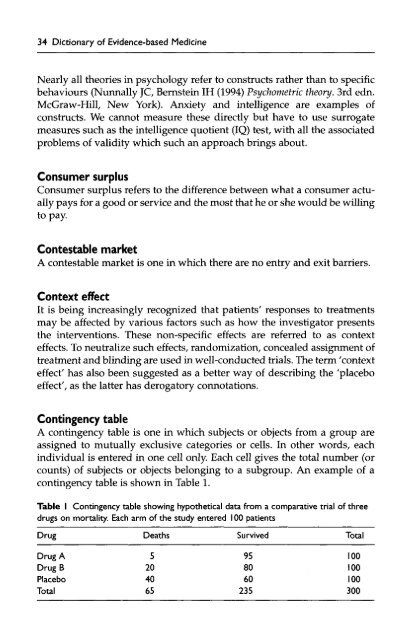Dictionary of Evidence-based Medicine.pdf
Dictionary of Evidence-based Medicine.pdf
Dictionary of Evidence-based Medicine.pdf
You also want an ePaper? Increase the reach of your titles
YUMPU automatically turns print PDFs into web optimized ePapers that Google loves.
34 <strong>Dictionary</strong> <strong>of</strong> <strong>Evidence</strong>-<strong>based</strong> <strong>Medicine</strong><br />
Nearly all theories in psychology refer to constructs rather than to specific<br />
behaviours (Nunnally JC, Bernstein IH (1994) Psychometric theory. 3rd edn.<br />
McGraw-Hill, New York). Anxiety and intelligence are examples <strong>of</strong><br />
constructs. We cannot measure these directly but have to use surrogate<br />
measures such as the intelligence quotient (IQ) test, with all the associated<br />
problems <strong>of</strong> validity which such an approach brings about.<br />
Consumer surplus<br />
Consumer surplus refers to the difference between what a consumer actually<br />
pays for a good or service and the most that he or she would be willing<br />
to pay.<br />
Contestable market<br />
A contestable market is one in which there are no entry and exit barriers.<br />
Context effect<br />
It is being increasingly recognized that patients' responses to treatments<br />
may be affected by various factors such as how the investigator presents<br />
the interventions. These non-specific effects are referred to as context<br />
effects. To neutralize such effects, randomization, concealed assignment <strong>of</strong><br />
treatment and blinding are used in well-conducted trials. The term 'context<br />
effect' has also been suggested as a better way <strong>of</strong> describing the 'placebo<br />
effect', as the latter has derogatory connotations.<br />
Contingency table<br />
A contingency table is one in which subjects or objects from a group are<br />
assigned to mutually exclusive categories or cells. In other words, each<br />
individual is entered in one cell only. Each cell gives the total number (or<br />
counts) <strong>of</strong> subjects or objects belonging to a subgroup. An example <strong>of</strong> a<br />
contingency table is shown in Table 1.<br />
Table I Contingency table showing hypothetical data from a comparative trial <strong>of</strong> three<br />
drugs on mortality. Each arm <strong>of</strong> the study entered 100 patients<br />
Drug Deaths Survived Total<br />
Drug A<br />
Drug B<br />
Placebo<br />
Total<br />
5<br />
20<br />
40<br />
65<br />
95<br />
80<br />
60<br />
235<br />
100<br />
100<br />
100<br />
300










